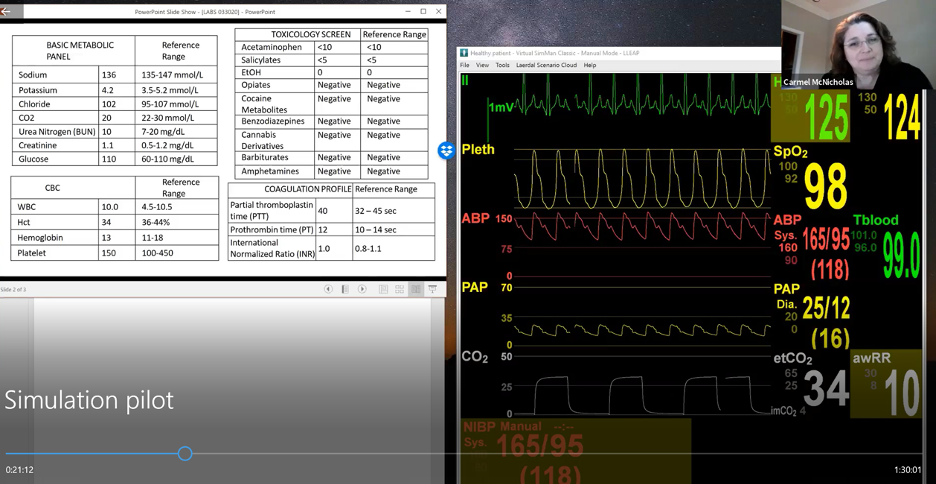Carmel McNicholas-Bevensee, PhD
 When in-person classes were canceled following the Covid-19 pandemic, inspired by Tele-Health, we rapidly converted BHS 610 Clinical Application and Simulation to a virtual platform. During the normal class schedule, ~40 learners either observe or participate in simulation in the Volker Hall Simulation Center (Sandbox). We were able to deliver a similar learning experience with online simulation utilizing Zoom.
When in-person classes were canceled following the Covid-19 pandemic, inspired by Tele-Health, we rapidly converted BHS 610 Clinical Application and Simulation to a virtual platform. During the normal class schedule, ~40 learners either observe or participate in simulation in the Volker Hall Simulation Center (Sandbox). We were able to deliver a similar learning experience with online simulation utilizing Zoom.A group of four learners played the role of the health care team, while the remainder of the group observed. We delivered a modified pre-brief to explain the format and roles of the various facilitators. One facilitator played the role of the patient (Carmel McNicholas-Bevensee, Cell, Developmental and Integrative Biology), another the ESP/clinical consult (MS-3 Taylor Bono), and a third the pharmacist (Jorge Lopez, School of Health Professions). The facilitator who played the role of the patient was also responsible for the patient monitor and delivering labs and images.
Utilizing a two-screen set-up, the zoom video feed was displayed on one screen (screen 1), and the second screen (screen 2 – example in the picture above) displayed the patient monitor and information. Screen 2 was shared. The Laerdal LLEAP software (free to download) was used in instructor mode (choose local computer and ‘enter license later’) and all screens except the monitor were disabled to minimize distractions. Ahead of time, each aspect of the patient monitor that was to be changed was opened and dragged to screen 1 so changes could be made without the learner observing. Patient measurements on the monitor were pre-loaded in multiple Powerpoint files with page 1 blank and displayed at the appropriate time during the simulation. Patient vitals were set to change over the course of several minutes for smooth transitions.
If a patient status change (e.g. loss of consciousness) was part of the simulation, a page on the Powerpoint stated this and was displayed at the appropriate time at which time the ‘patient’ no longer responded to the participants. We also captured videos, converted to MP4s, and had them ready to display in the Powerpoint files. Examples include a video of a doppler monitor to simulate pregnancy and a video of a patient seizing. We also utilized an online defibrillator simulator. It was important to open all Powerpoint screens ahead of time on screen 2, then minimize and open from the screen 1 tray. This minimized the learners observing the ‘behind the scenes’ transitions as much as possible. After the simulation concluded, we debriefed with the whole group using the standard OIPS format. After the pilot simulation, we sought feedback. 96% of the respondents stated they thought this was a positive learning experience (strongly/somewhat agree). Thanks to OIPS team member Tyler Burks for technical advice.